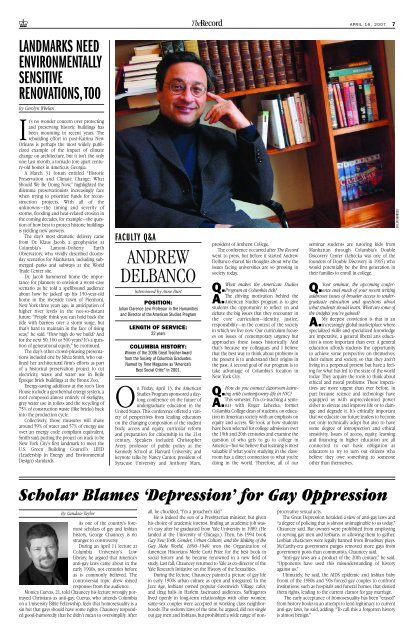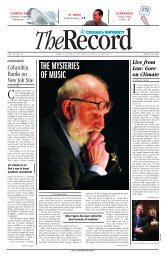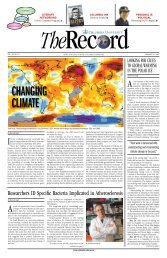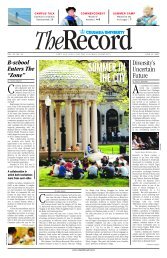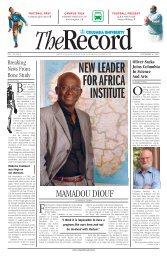April 16, 2007 - Columbia News - Columbia University
April 16, 2007 - Columbia News - Columbia University
April 16, 2007 - Columbia News - Columbia University
- No tags were found...
Create successful ePaper yourself
Turn your PDF publications into a flip-book with our unique Google optimized e-Paper software.
LANDMARKS NEEDENVIRONMENTALLYSENSITIVERENOVATIONS,TOOBy Carolyn WhelanTheRecord APRIL <strong>16</strong>, <strong>2007</strong> 7It’s no wonder concern over protectingand preserving historic buildings hasbeen mounting in recent years. Therebuilding effort in post-Katrina NewOrleans is perhaps the most widely publicizedexample of the impact of climatechange on architecture, but it isn’t the onlyone: Last month, a tornado tore apart century-oldhomes in Americus, Georgia.A March 31 forum entitled “HistoricPreservation and Climate Change: WhatShould We Be Doing Now,” highlighted thedilemma preservationists increasingly facewhen trying to prioritize funds for reconstructionprojects. With all of theunknowns—the timing and severity ofstorms, flooding and heat-related erosion inthe coming decades, for example—the questionof how best to protect historic buildingsis yielding new answers.The day’s most dramatic delivery camefrom Dr. Klaus Jacob, a geophysicist at<strong>Columbia</strong>’s Lamont-Doherty EarthObservatory, who vividly described doomsdayscenarios for Manhattan, including submergedparks and subways at the WorldTrade Center site.Dr. Jacob hammered home the importancefor planners to envision a worst-casescenario as he told a spellbound audienceabout how he jacked up his 150-year-oldhome in the riverside town of Piermont,New York three years ago, in anticipation ofhigher river levels in the not-so-distantfuture. “People think you can hold back thetide with barriers over a storm surge, butthat’s hard to maintain in the face of risingseas,” he said. “How high do we build? Andfor the next 50, 100 or 500 years? It’s a questionof generational equity,” he continued.The day’s other crowd-pleasing presentationsincluded one by Silvia Smith, who outlinedher architectural firm’s efforts as partof a historical preservation project to cutelectricity, waste and water use in BelleÉpoque brick buildings at the Bronx Zoo.Energy-saving additions at the zoo’s LionHouse include a geothermal energy system, aroof composed almost entirely of skylights,grey water use in toilets and the recycling of75% of construction waste (like bricks) backinto the production cycle.Collectively, those measures will shavearound 59% of water and 57% of energy useover an energy code compliant equivalent,Smith said, putting the project on track to beNew York City’s first landmark to meet theU.S. Green Building Council’s LEED(Leadership in Energy and EnvironmentalDesign) standards.FACULTY Q&AANDREWDELBANCOInterviewed by Anne BurtPOSITION:Julian Clarence Levi Professor in the Humanitiesand Director of the American Studies ProgramLENGTH OF SERVICE:22 yearsCOLUMBIA HISTORY:Winner of the 2006 Great Teacher Awardfrom the Society of <strong>Columbia</strong> Graduates.Named by Time Magazine as “America’sBest Social Critic” in 2001.On Friday, <strong>April</strong> 13, the AmericanStudies Program sponsored a daylongconference on the future ofundergraduate education in theUnited States. This conference offered a varietyof perspectives from leading educatorson the changing composition of the studentbody, access and equity, curricular reformand preparation for citizenship in the 21stcentury. Speakers included ChristopherAvery, professor of public policy at theKennedy School at Harvard <strong>University</strong>, andkeynote talks by Nancy Cantor, president ofSyracuse <strong>University</strong> and Anthony Marx,president of Amherst College.The conference occurred after The Recordwent to press, but before it started AndrewDelbanco shared his thoughts about why theissues facing universities are so pressing insociety today.What makes the American StudiesQ. Program at <strong>Columbia</strong> tick?The driving motivation behind theA. American Studies program is to givestudents the opportunity to reflect on anddebate the big issues that they encounter inthe core curriculum—identity, justice,responsibility—in the context of the societyin which we live now. Our curriculum focuseson issues of contemporary urgency butapproaches these issues historically. Andthat’s because my colleagues and I believethat the best way to think about problems inthe present is to understand their origins inthe past. A second goal of our program is totake advantage of <strong>Columbia</strong>’s location inNew York City.How do you connect classroom learningwith contemporary life in NYC?Q.This semester, I’m co-teaching a seminarwith Roger Lehecka, formerA.<strong>Columbia</strong> College dean of students, on educationin American society with an emphasis onequity and access. We look at how studentshave been selected for college admission overthe 19th and 20th centuries and examine thequestion of who gets to go to college inAmerica—but we believe that learning is mostvaluable if what you’re studying in the classroomhas a direct connection to what you’redoing in the world. Therefore, all of ourseminar students are tutoring kids fromManhattan through <strong>Columbia</strong>’s DoubleDiscovery Center (Lehecka was one of thefounders of Double Discovery in 1965) whowould potentially be the first generation intheir families to enroll in college.Your seminar, the upcoming conferenceand much of your recent writingQ.addresses issues of broader access to undergraduateeducation and questions aboutwhat students should learn. What are some ofthe insights you’ve gained?My deepest conviction is that in anA. increasingly global marketplace wherespecialized skills and specialized knowledgeare imperative, a general liberal arts educationis more important than ever. A generaleducation affords students the opportunityto achieve some perspective on themselves,their culture and society, so that they aren’tliving in a perpetual present but have a feelingfor what has led to the state of the worldtoday. They acquire the tools to think aboutethical and moral problems. These imperativesare more urgent than ever before, inpart because science and technology haveequipped us with unprecedented powereither to elevate and improve life or to damageand degrade it. It’s critically importantthat we educate our future leaders to becomenot only technically adept but also to havesome degree of introspection and ethicalsensitivity. Issues of access, equity, learningand financing in higher education are allconnected to our basic obligation aseducators to try to turn out citizens whobelieve they owe something to someoneother than themselves.EILEEN BARROSOScholar Blames ‘Depression’ for Gay OppressionBy Candace TaylorAs one of the country’s foremostscholars of gay and lesbianhistory, George Chauncey is nostranger to controversy.During an <strong>April</strong> 11 lecture at<strong>Columbia</strong> <strong>University</strong>’s LowLibrary, he argued that America’santi-gay laws came about in theearly 1900s, not centuries beforeas is commonly believed. Thecontroversial topic drew mixedresponses from the audience.Monica Cuevas, 21, told Chauncey his lecture wrongly portrayedChristians as anti-gay. Cuevas, who attends <strong>Columbia</strong>on a <strong>University</strong> Bible Fellowship, feels that homosexuality is asin but that gays should have some rights. Chauncey respondedgood-humoredly that he didn’t mean to oversimplify. Afterall, he chuckled, “I’m a preacher’s kid.”He is indeed the son of a Presbyterian minister, but givenhis choice of academic interest, finding an academic job wasn’teasy after he graduated from Yale <strong>University</strong> in 1989. (Helanded at the <strong>University</strong> of Chicago.). Then, his 1994 bookGay New York: Gender, Urban Culture, and the Making of theGay Male World, 1890-1940 won the Organization ofAmerican Historians Merle Curti Prize for the best book insocial history and he became renowned in a new field ofstudy. Last fall, Chauncey returned to Yale as co-director of theYale Research Initiative on the History of the Sexualities.During the lecture, Chauncey painted a picture of gay lifein early 1900s urban culture as open and integrated. In theJazz Age, lesbians owned popular Greenwich Village cafes,and drag balls in Harlem fascinated audiences. Suffragetteslived openly in long-term relationships with other women;same-sex couples were accepted in working class neighborhoods.The sodomy laws of the time, he argued, did not singleout gay men and lesbians, but prohibited a wide range of nonprocreativesexual acts.The Great Depression heralded a slew of anti-gay laws and“a degree of policing that is almost unimaginable to us today,”Chauncey said. Bar owners were prohibited from employingor serving gay men and lesbians, or allowing them to gather.Lesbian characters were legally banned from Broadway plays.McCarthy-era government purges removed more gays fromgovernment posts than communists, Chauncey said.“Anti-gay laws are a product of the 20th century,” he said.“Opponents have used this misunderstanding of historyagainst us.”Ultimately, he said, the AIDS epidemic and lesbian babyboom of the 1980s and ’90s forced gay couples to confrontinstitutions, such as hospitals and funeral homes, that deniedthem rights, leading to the current clamor for gay marriage.The early acceptance of homosexuality has been “erased”from history books in an attempt to lend legitimacy to currentanti-gay laws, he said, adding: “To call this a forgotten historyis almost benign.”


